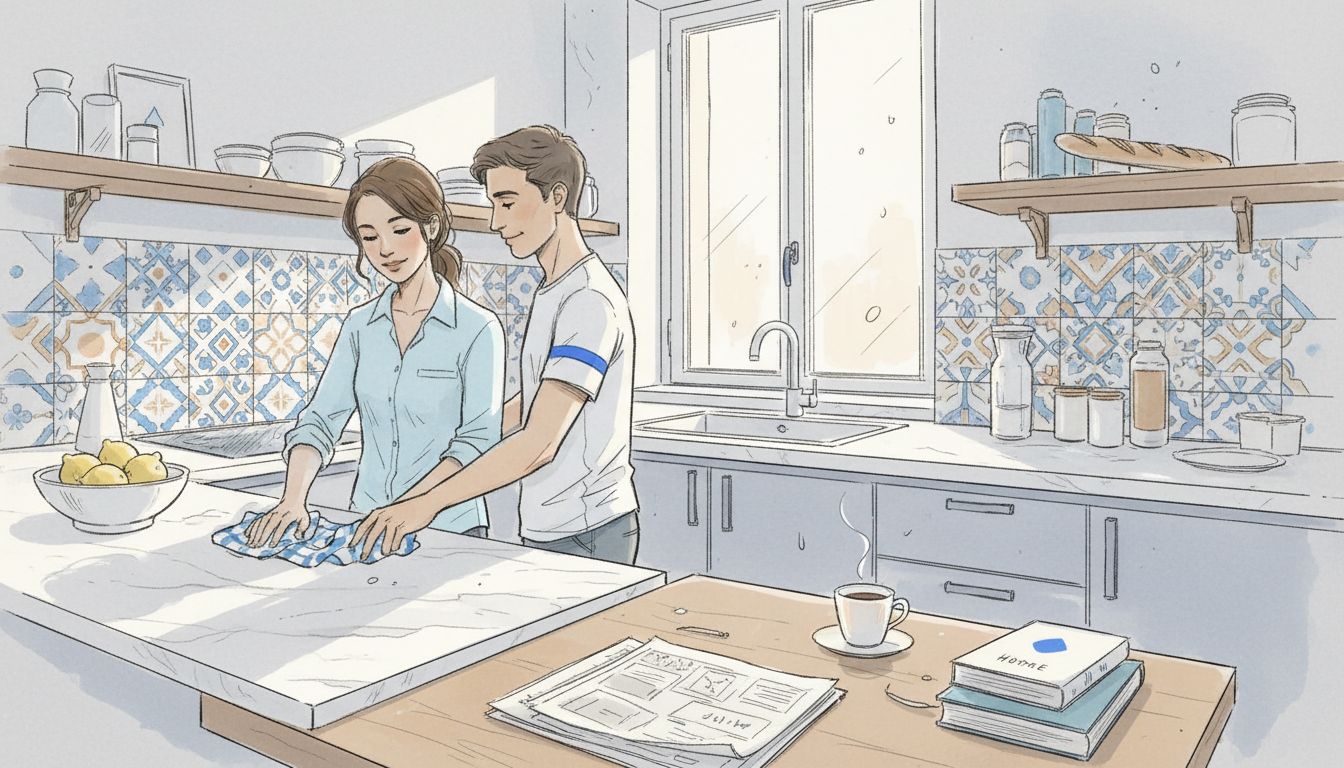Everyone dreams of a clean house but keeping it spotless often feels overwhelming. Turns out, over 50 percent of people admit they regularly skip major cleaning tasks because they have no schedule to follow. Now here is where things get surprising. You do not need more time or expensive tools. Most people just need a simple plan that matches their real life and keeps the chaos in check.
Table of Contents
- Create A Simple Cleaning Schedule
- Prioritize Cleaning Tasks By Importance
- Use A Checklist For Efficiency
- Set Cleaning Goals To Stay Motivated
- Involve Family Members In The Plan
- Adjust Your Plan Seasonally
- Review And Tweak Your Planner Regularly
Quick Summary
| Takeaway | Explanation |
|---|---|
| Create a realistic cleaning schedule | Establish specific daily, weekly, and monthly tasks to maintain consistency and avoid feeling overwhelmed. |
| Prioritize cleaning tasks effectively | Focus on high-impact areas such as kitchens and bathrooms to enhance health and hygiene at home. |
| Use checklists for efficient cleaning | Implement room-by-room checklists to break down tasks and track progress, enhancing your cleaning routine. |
| Set SMART goals for motivation | Define specific, measurable, achievable, relevant, and time-bound goals to keep your cleaning efforts focused and rewarding. |
| Involve family members in cleaning | Engage all household members in chores to distribute workload and promote shared responsibility for a cleaner home. |
1: Create a Simple Cleaning Schedule
Designing a household cleaning planner starts with establishing a straightforward and realistic cleaning schedule. A well-structured plan transforms sporadic cleaning efforts into a consistent and manageable routine. Without a clear schedule, household cleaning can feel overwhelming and lead to procrastination.
According to Consumer Reports, effective cleaning schedules typically include different task categories based on frequency:
- Daily Tasks: Quick maintenance like making beds, wiping kitchen counters, and doing dishes
- Weekly Tasks: More comprehensive cleaning such as vacuuming, dusting, and bathroom sanitization
- Monthly Tasks: Deep cleaning activities including washing windows, cleaning under furniture
To create your personalized cleaning schedule, start by taking inventory of your living space and understanding your specific cleaning needs. Consider your work schedule, family dynamics, and available time. Realistic planning is key to maintaining consistency.
Break down tasks into manageable chunks and assign them specific days. For instance, dedicate Mondays to laundry, Tuesdays to bathroom cleaning, and Wednesdays to kitchen deep cleaning. This approach prevents task accumulation and distributes workload evenly.
Digital tools can significantly enhance your cleaning organization strategy. Use smartphone apps or digital calendars to set reminders and track your cleaning progress. Visual tracking helps maintain motivation and ensures no task gets overlooked.
Remember, a cleaning schedule is not about perfection but about creating a sustainable system that keeps your living space consistently clean and comfortable.
2: Prioritize Cleaning Tasks by Importance
Not all cleaning tasks carry equal weight in maintaining a healthy home environment. Effective household cleaning planners recognize the importance of strategic task prioritization. By understanding which tasks significantly impact home hygiene and comfort, you can allocate time and energy more efficiently.
According to University of Minnesota Extension, cleaning tasks can be categorized by their immediate and long-term impact:
- High Priority Tasks: Kitchen and bathroom cleaning, addressing areas with high bacteria potential
- Medium Priority Tasks: Vacuuming, dusting living spaces
- Low Priority Tasks: Organizing storage areas, deep cleaning rarely used spaces
Prioritization involves understanding potential health and maintenance risks. Areas like kitchen counters, bathroom surfaces, and high-touch points require more frequent and thorough cleaning to prevent bacterial growth and potential illness transmission.
Consider the time investment and impact of each cleaning task. For instance, daily quick wipe-downs of kitchen surfaces take minimal time but provide substantial hygiene benefits. In contrast, organizing a closet might look impressive but offers less immediate health protection.
Factors influencing task prioritization include household composition, lifestyle, and specific health considerations. Homes with young children, pets, or individuals with allergies might need more frequent cleaning of specific areas.
Technology can help streamline your cleaning management approach. Digital tools and apps can help track task importance, set reminders, and ensure consistent maintenance of critical home areas.
Remember, a smart household cleaning planner balances thoroughness with practicality, focusing energy where it creates the most significant impact on home cleanliness and family health.
3: Use a Checklist for Efficiency
A household cleaning planner becomes exponentially more effective when supported by a structured checklist. Checklists transform abstract cleaning goals into concrete, actionable tasks that can be systematically tracked and completed.
According to North Carolina Cooperative Extension, creating a comprehensive cleaning checklist helps break down overwhelming tasks into manageable steps.
Key elements of an effective cleaning checklist include:
- Room-by-Room Breakdown: Specific tasks for each living space
- Time Allocation: Estimated duration for each cleaning activity
- Frequency Indicators: Daily, weekly, monthly task designations
- Tracking Mechanism: Space to mark completed tasks
Digital and physical checklists both offer unique advantages. Paper checklists provide tactile satisfaction of physically marking tasks complete, while digital versions offer reminders, cloud synchronization, and easy modifications.
When designing your checklist, consider your specific household needs. A single professional might require a different cleaning approach compared to a family with multiple children or pets. Customize your checklist to reflect your living situation and cleaning priorities.
Technology can significantly enhance checklist management. Smartphone apps and digital tools provide intuitive interfaces for creating, tracking, and updating cleaning tasks. Some cleaning services even offer pre-designed templates that can be personalized to individual requirements.
The psychological benefit of using a checklist cannot be overstated. Checking off completed tasks provides a sense of accomplishment and motivation, transforming cleaning from a dreaded chore into a structured, satisfying process.
Remember, a good checklist is flexible. Regularly review and adjust your cleaning plan to ensure it remains practical and aligned with your evolving lifestyle and home maintenance needs.
4: Set Cleaning Goals to Stay Motivated
Motivation is the critical engine that transforms a household cleaning planner from a static document into an actionable strategy. Without clear, achievable goals, even the most meticulously designed cleaning plan can quickly fall apart.
According to the U.S. Department of Homeland Security, establishing SMART goals can dramatically improve task completion and personal motivation. SMART goals are:
- Specific: Clearly defined cleaning objectives
- Measurable: Quantifiable targets you can track
- Achievable: Realistic within your current lifestyle
- Relevant: Aligned with your home maintenance needs
- Time-bound: With clear deadlines and timelines
Psychological rewards play a significant role in maintaining cleaning motivation. Breaking larger cleaning projects into smaller, manageable tasks creates a sense of progressive achievement. For example, instead of overwhelming yourself with “clean the entire house,” set specific goals like “organize one kitchen drawer” or “dust living room surfaces”.
Visual tracking methods can significantly boost motivation. Consider creating a reward system or using color-coded progress charts that provide immediate visual feedback on your cleaning accomplishments. Some people find satisfaction in physically checking off completed tasks or using digital apps that gamify household maintenance.
Personalize your goals to match your unique living situation. A busy professional might set different cleaning objectives compared to a stay-at-home parent. Flexibility and self-compassion are key components of a sustainable cleaning motivation strategy.
Cleaning can actually be an enjoyable experience when approached with the right mindset. Transform mundane tasks into opportunities for personal satisfaction and home improvement.
Remember, motivation fluctuates. On days when cleaning feels challenging, focus on small wins and be kind to yourself. Consistent, incremental progress ultimately leads to a cleaner, more organized living space.
5: Involve Family Members in the Plan
A household cleaning planner is most effective when it transforms from an individual responsibility to a collaborative family effort. Engaging all household members not only distributes workload but also teaches valuable life skills and promotes shared accountability.
According to research in the International Journal of Environmental Research and Public Health, family collaboration in domestic cleaning significantly improves psychological well-being and reduces individual task stress.
Strategies for successful family cleaning involvement include:
- Age-Appropriate Tasks: Assign cleaning responsibilities matching each family member’s capabilities
- Clear Communication: Explain expectations and demonstrate proper cleaning techniques
- Positive Reinforcement: Recognize and appreciate contributions
- Rotating Responsibilities: Prevent task monotony by switching roles periodically
Children can be particularly receptive to structured cleaning participation. Young kids might enjoy simple tasks like picking up toys or sorting laundry, while teenagers can handle more complex cleaning assignments such as vacuuming or bathroom maintenance.
Creating a visual family cleaning chart can make the process more engaging. Use colorful stickers or digital tracking apps to mark completed tasks, turning cleaning into a potentially fun and competitive activity. Some families implement reward systems or small incentives to maintain motivation.
Technology offers innovative ways to coordinate family cleaning efforts. Shared digital calendars, task management apps, and family communication platforms can help synchronize cleaning schedules and track individual contributions.
Professional cleaning services can also provide guidance on effective family cleaning strategies if additional support is needed.
Remember that consistency and patience are key. Developing a family cleaning routine takes time. Approach the process with understanding, and gradually build a collaborative household maintenance culture that feels supportive rather than punitive.
6: Adjust Your Plan Seasonally
A dynamic household cleaning planner adapts to changing environmental conditions and lifestyle shifts throughout the year. Seasonal variations demand unique cleaning approaches that address specific challenges and maintenance requirements.
Each season introduces distinct cleaning needs that require strategic modifications to your standard household cleaning routine. Summer might demand more frequent floor cleaning due to increased outdoor activity, while winter requires extra attention to indoor spaces and potential moisture accumulation.
Key seasonal cleaning considerations include:
- Spring: Deep cleaning, window washing, decluttering
- Summer: Increased dust and dirt management, outdoor space maintenance
- Autumn: Preparing indoor spaces for colder months, addressing potential moisture issues
- Winter: Managing indoor air quality, preventing mold and mildew
Seasonal adjustments go beyond standard cleaning tasks. Consider how weather changes impact your home’s specific maintenance requirements. Humid summers might necessitate more frequent bathroom and kitchen deep cleans, while winter demands extra attention to indoor air circulation and potential condensation areas.
Technology can help track and manage seasonal cleaning variations. Digital cleaning planners allow you to create seasonal templates, set specific reminders, and adapt your cleaning strategy with minimal effort. Some apps even provide location-based cleaning recommendations based on local weather conditions.
Materials and equipment also require seasonal recalibration. Summer might require lighter cleaning solutions and more frequent use of fans, while winter could demand more robust cleaning agents and strategies for managing indoor humidity.
Cleaning service professionals often recommend creating a flexible, season-specific cleaning approach that anticipates potential household challenges.
Remember that flexibility is the cornerstone of an effective seasonal cleaning strategy. Be prepared to modify your approach, invest in appropriate cleaning tools, and remain adaptable to your home’s evolving maintenance needs throughout the year.
7: Review and Tweak Your Planner Regularly
A household cleaning planner is a living document that requires consistent evaluation and adaptation. Static plans quickly become obsolete, failing to reflect changing household dynamics, lifestyle shifts, and evolving maintenance needs.
According to the UK Government’s guidance, establishing and regularly reviewing a cleaning schedule ensures tasks are performed efficiently and effectively.
Key aspects to consider during your household cleaning planner review include:
- Task Effectiveness: Assess which cleaning strategies are working
- Time Management: Evaluate current time allocations for different tasks
- Family Dynamics: Adjust plan based on changing household needs
- Personal Energy Levels: Modify tasks to match your current capacity
- Budget Constraints: Review potential cleaning investments
Quarterly reviews provide an ideal frequency for reassessing your cleaning strategy. During these evaluations, critically examine what’s functioning well and identify areas requiring modification. Technology offers numerous tools to streamline this process, from digital tracking apps to cloud-based planning platforms.
Consider tracking metrics that demonstrate your cleaning plan’s performance. These might include time spent cleaning, task completion rates, or subjective measures like home cleanliness satisfaction. Quantifiable data helps make objective improvements to your household cleaning approach.
Flexibility remains crucial. Life circumstances change rapidly – a new pet, a work schedule shift, or health considerations can dramatically impact cleaning requirements. Your household cleaning planner should be adaptable enough to accommodate these transitions seamlessly.
Professional cleaning services often recommend maintaining a dynamic approach to home maintenance, understanding that one-size-fits-all strategies rarely work effectively.
Remember that perfection is not the goal. A good cleaning plan is about consistent progress, not achieving an impossible standard of immaculateness. Approach your reviews with compassion, pragmatism, and a commitment to continuous improvement.
Below is a comprehensive table summarizing the seven essential tips for creating and maintaining an effective household cleaning planner as described in the article.
| Tip | Core Strategy | Key Benefits |
|---|---|---|
| Create a Simple Cleaning Schedule | Establish daily, weekly, and monthly tasks tailored to your life | Promotes consistency; reduces overwhelm; easier task management |
| Prioritize Cleaning Tasks by Importance | Focus on high-impact, hygiene-sensitive areas first | Maximizes home health and efficiency; saves time |
| Use a Checklist for Efficiency | Utilize room-by-room and frequency-based checklists | Enhances organization; tracks progress; increases motivation |
| Set Cleaning Goals to Stay Motivated | Implement SMART goals (Specific, Measurable, Achievable, Relevant, Time-bound) | Keeps efforts targeted; provides satisfaction and rewards |
| Involve Family Members in the Plan | Assign age-appropriate tasks and rotate responsibilities | Distributes the workload; builds accountability; teaches skills |
| Adjust Your Plan Seasonally | Adapt plan for seasonal changes and maintenance requirements | Addresses unique cleaning demands throughout the year |
| Review and Tweak Your Planner Regularly | Conduct quarterly reviews and adjust as needed | Keeps plan relevant; improves effectiveness; supports flexibility |
Make Your Cleaning Planner Effortless with Malta’s #1 Cleaning Solution
Struggling to stay consistent with your household cleaning planner? Planning family routines, setting goals, and adapting to seasonal changes can feel overwhelming, especially when life gets busy. Our article discussed the stress of keeping track of cleaning checklists, prioritizing urgent areas, and motivating everyone at home to pitch in. You deserve a simple way to keep your space fresh without losing precious time or energy.
Visit our Cleaning in Malta resource for expert solutions tailored to Malta’s households and see how modern tools can turn your cleaning plan into a stress-free routine.

Take action today and transform how you manage your home. Choose Rozie to connect you with trusted local cleaning professionals who keep your planner—and your home—on track. Streamline your daily, weekly, and monthly tasks while gaining peace of mind. Explore more tips and join others who made cleaning simple with Rozie – Malta’s Best Cleaning Services. Your smarter household cleaning journey starts now at https://rozie.app.
Frequently Asked Questions
How can I create an effective cleaning schedule for my household?
To create an effective cleaning schedule, identify daily, weekly, and monthly tasks. Break down the cleaning activities into manageable chunks and assign them to specific days to streamline your routine and maintain consistency.
What are some high-priority cleaning tasks I should focus on?
High-priority cleaning tasks often include kitchen and bathroom cleaning, as these areas tend to harbor more bacteria. Quick daily maintenance tasks, such as wiping down surfaces, should also be a part of your routine.
How can I motivate my family to participate in cleaning tasks?
To motivate your family, assign age-appropriate tasks and communicate expectations clearly. Positive reinforcement and a visual cleaning chart can make the process engaging, while rotating responsibilities prevents monotony.
Why is it important to review and adjust my cleaning planner regularly?
Regularly reviewing your cleaning planner allows you to assess task effectiveness, adjust for changes in family dynamics, and ensure your cleaning strategy remains practical and aligned with your current lifestyle needs.
Recommended
- The Cleaning Craze: Everyone’s Suddenly Talking About Cleaning
- Cleaners in Malta: How to find reliable professional?
- Rozie Cleaner Requirements: Start Your Career in Malta!
- Why Watching Other People Clean Feels So Good, Malta edition.
- Step by Step Household Hacks for Daily Efficiency – breezytips.com
- How To Clean After Pest Treatment – Pest Control Van Alstyne, TX – Pestico Pest Control



